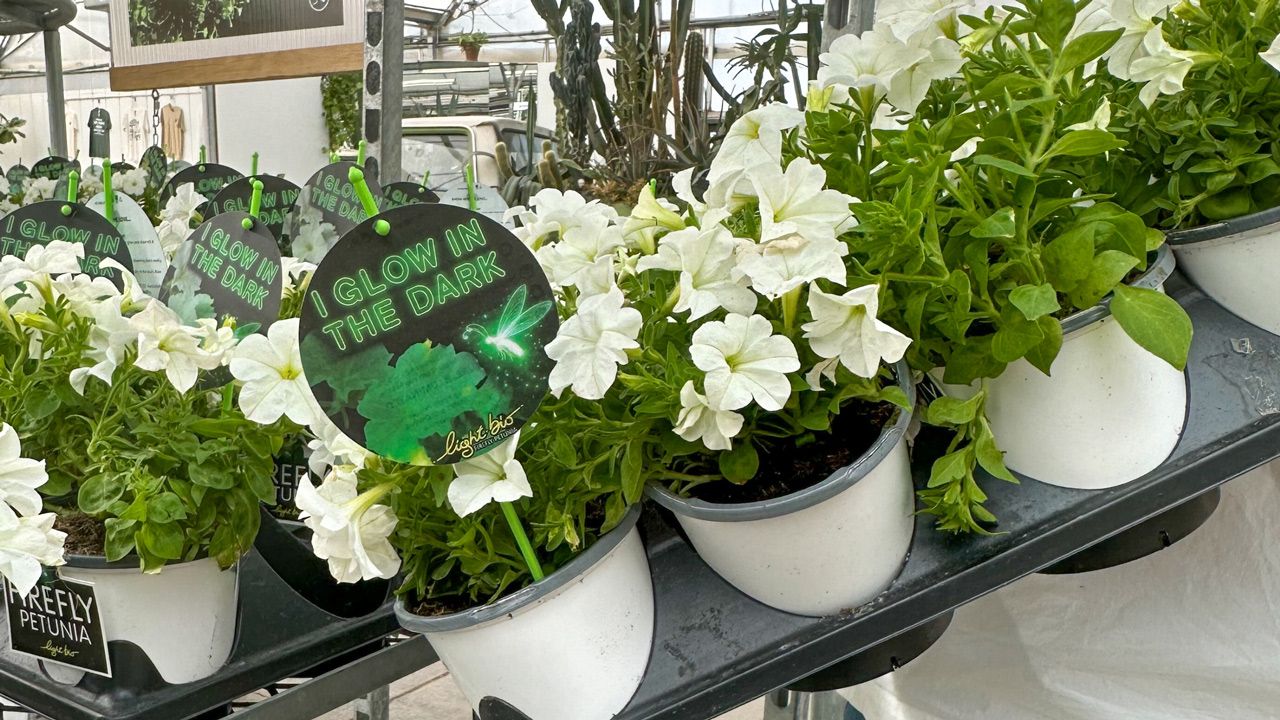
Firefly Petunias are a stunning addition to any garden, offering vibrant colors by day and a soft, enchanting glow by night. But these aren’t just any petunias – they’re history in the making. Developed by a team of scientists, plant lovers, and dreamers, Firefly Petunias are the world’s first light-emitting flower. Thanks to a little help from bioluminescent mushrooms (yes, really), these petunias glow in the dark, providing a natural, soft glow in low light.

We’re one of the first places in the country where you can see this wonder in person – the ultimate way to reimagine your night garden. As Mike Reynolds, our bioluminescent plant specialist, puts it, “Bag it, tag it, glow it in the dark. It shines through. It’s a ‘beacon in the void.’” Whether you’re winding down after a long day or just want to add some magical ambiance to your space, Firefly Petunias bring a little scientific magic to everyday life. And yes, they’re completely safe, totally real, and unlike anything you’ve ever seen grown before.
To help you get the most out of your Firefly Petunias, here’s a simple care guide.
A Magical Flower Like No Other
Firefly Petunias are a stunning addition to any garden, offering vibrant colors by day and a soft, enchanting glow by night. But these aren’t just any petunias – they’re history in the making.
Developed by a team of scientists, plant lovers, and dreamers, Firefly Petunias are the world’s first light-emitting flower. Thanks to a little help from bioluminescent mushrooms (yes, really), these petunias glow in the dark, providing a natural, soft glow in low light.
See Them at Mulhalls
We’re one of the first places in the country where you can see this wonder in person – the ultimate way to reimagine your night garden. As Mike Reynolds, our bioluminescent plant specialist, puts it,
“Bag it, tag it, glow it in the dark. It shines through. It’s a ‘beacon in the void.’”
Whether you’re winding down after a long day or just want to add some magical ambiance to your space, Firefly Petunias bring a little scientific magic to everyday life. And yes, they’re completely safe, totally real, and unlike anything you’ve ever seen grown before.

To help you get the most out of your Firefly Petunias, here’s a simple care guide.
1. Sunlight: Full Sun for Maximum Glow
Firefly Petunias thrive in full sun, so make sure they get at least 6 to 8 hours of direct sunlight every day. Sunlight not only supports strong growth but also enhances their bioluminescent glow, making your garden shine at night.
2. Watering: Keep the Soil Moist, But Not Soggy
Water your Firefly Petunias regularly, especially if they’re in containers or experiencing hot weather. However, they don’t like sitting in soggy soil. Let the soil dry out slightly between waterings to ensure the roots stay healthy and avoid root rot.
3. Fertilizing: Feed for Full-Bloom Beauty
These petunias are heavy feeders. Fertilize every 1–2 weeks with a balanced, water-soluble fertilizer (like 10-10-10 or 20-20-20) to support their growth and keep those vibrant blooms coming.
If you’re growing them in containers, you may also want to add a slow-release fertilizer for steady, long-term nourishment.
4. Deadheading and Pruning: Keep Them Blooming
To encourage more flowers and maintain a neat appearance, deadhead spent blooms regularly. If your Firefly Petunias become leggy or spindly mid-season, prune them back by about one-third to promote bushier growth and healthier plants.
5. Protection from Wind and Rain
While Firefly Petunias are quite hardy, they’re best protected from harsh weather like strong winds and heavy rain. Place them in sheltered spots or use hanging baskets under eaves to help preserve their delicate flowers and maximize their lifespan.
6. Planting Tips: Compostable Pots for Easy Transition
Firefly Petunias are often sold in compostable paper pots. There’s no need to remove the liner—just plant the whole pot directly into the soil. This reduces transplant shock and supports better root development.
Enjoy the Glow
With these simple care tips, your Firefly Petunias will thrive, adding a touch of magic and color to your garden all season long. Enjoy the glow and beauty they bring to your outdoor space!

FAQ: Firefly Petunias
Q: How long will Firefly Petunias glow?
A: Firefly Petunias typically glow at their brightest during the warmer months when they receive ample sunlight. The glow is most visible during the evening or in darker settings. The intensity of the glow will vary depending on light exposure and environmental factors.
Q: Do Firefly Petunias need special soil?
A: Firefly Petunias thrive in well-drained soil. Use a general-purpose potting mix with good drainage to keep the roots healthy. Make sure the soil is slightly acidic to neutral for optimal growth.
Q: Can Firefly Petunias survive the winter?
A: Firefly Petunias are generally grown as annuals in most climates. They will not survive freezing temperatures, so it’s best to bring them indoors before the first frost if you want to try to keep them as houseplants.
Q: Will Firefly Petunias attract pests?
A: Like most petunias, Firefly Petunias may attract pests like aphids, slugs, or caterpillars. Regularly inspect your plants and use gentle pest control methods to keep them healthy.
Q: Can I grow Firefly Petunias in containers?
A: Absolutely! Firefly Petunias do well in containers. Just ensure the pot has drainage holes and that you provide regular watering and feeding. Containers are a great way to show off their glowing blooms.
Q: Can I plant Firefly Petunias in the ground?
A: Yes, Firefly Petunias can be planted in the ground as long as they’re in a sunny spot with well-drained soil. They will thrive in garden beds and add a unique glow to your landscape.
Ready to add some glow to your garden? Stop by and see these magical blooms in person! We’d love to help you get started with the perfect plants for your outdoor space.


